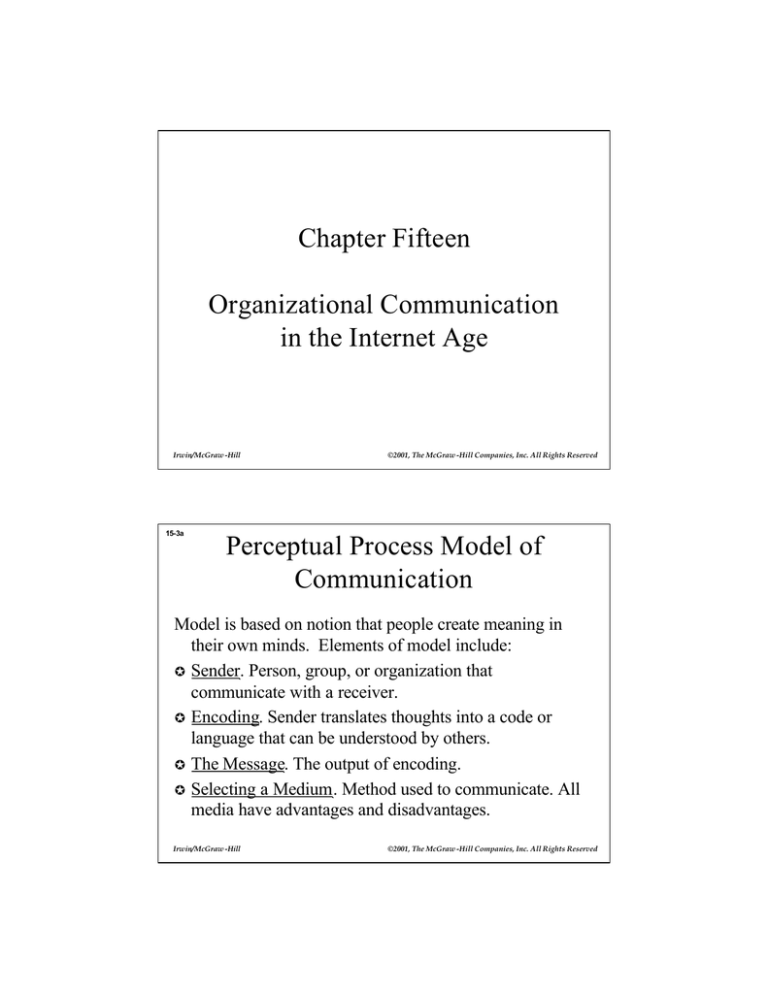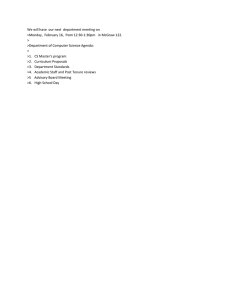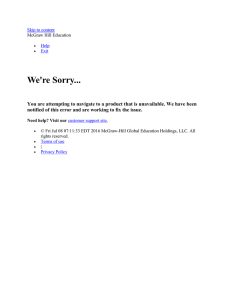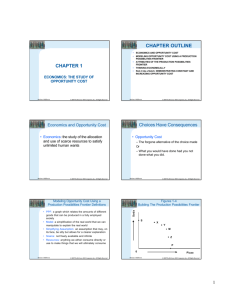
Chapter Fifteen
Organizational Communication
in the Internet Age
Irwin/McGraw -Hill
15-3a
©2001, The McGraw -Hill Companies, Inc. All Rights Reserved
Perceptual Process Model of
Communication
Model is based on notion that people create meaning in
their own minds. Elements of model include:
µ Sender. Person, group, or organization that
communicate with a receiver.
µ Encoding. Sender translates thoughts into a code or
language that can be understood by others.
µ The Message. The output of encoding.
µ Selecting a Medium. Method used to communicate. All
media have advantages and disadvantages.
Irwin/McGraw -Hill
©2001, The McGraw -Hill Companies, Inc. All Rights Reserved
15-2
Figure 15-1
A Perceptual Model of Communication
Encoding
Receiver
decodes
Receiver
creates
meaning
Noise
Sender
Source
decodes
Irwin/McGraw -Hill
15-3b
Transmitted
on medium
Message
Transmitted
on medium
Message
Encoding
©2001, The McGraw -Hill Companies, Inc. All Rights Reserved
Perceptual Process Model of
Communication
(continued)
Decoding. Receiver converts a message into a form
that can be interpreted.
µ Creating Meaning. Receivers interpret message by
using components of social information
processing.
µ Feedback. Receivers response to a message.
µ Noise. Anything that interferes with the
transmission and understanding of a message.
µ
Irwin/McGraw -Hill
©2001, The McGraw -Hill Companies, Inc. All Rights Reserved
15-5
Figure 15-4
Richness of Communication Medium
High
A Contingency Model for Selecting
Communication Media
Overload zone
(medium provides
more information
than necessary)
Zo
o
ne
fe
f
ti
fec
ve
m
co
Face-to-face
mu
n
ti
ica
Telephone
on
Personal
written
Formal
written
Oversimplification zone
(medium does not
provide necessary
information)
Formal
numeric
Low
Low
Complexity of Problem/Situation
Irwin/McGraw -Hill
High
©2001, The McGraw -Hill Companies, Inc. All Rights Reserved
One-Way vs. Two-Way
Communication
n One-Way
n
Advantages
n
Fast
Nonthreatening to sender
n
n
Disadvantages
n
Probability of misunderstanding
Receiver resentment
Receiver frustration
n
n
Irwin/McGraw -Hill
n Two-Way
n
Advantages
n
Clarification of message
n
n
Receiver input
Sender/Receiver involvement
n
Disadvantages
n
More time-consuming
Threatening to sender
n
©2001, The McGraw -Hill Companies, Inc. All Rights Reserved
15-8
Tips for Improving Nonverbal
Communication Skills
Maintain eye contact
l Occasionally nod your head
in agreement
l Smile and show animation
l Lean toward the speaker
l Speak at a moderate rate
l Use an assuring tone
l
Irwin/McGraw -Hill
©2001, The McGraw -Hill Companies, Inc. All Rights Reserved
15-12
Hierarchical Communication
v
v
v
Managers provide downward communication about
- job instructions
- job rationale
- organizational procedures and practices
- feedback about performance
- indoctrination of goals
Employees provide upward communication about
- themselves
- co-workers
- organizational practices and policies
- what needs to be done and how to do it
Timely and accurate hierarchical communication promotes
individual and organizational success
Irwin/McGraw -Hill
©2001, The McGraw -Hill Companies, Inc. All Rights Reserved
15-14
Communication Distortion
Communication Distortion: occurs when an employee
purposely modifies the content of a message.
l
Communication distortion is more likely when
- an employee’s supervisor has high upward influence
- an employee’s supervisor has the power to reward and
punish
- an employee aspires to getting promoted and moving up
the organizational hierarchy
- an employee does not trust his or her manager
Irwin/McGraw -Hill
©2001, The McGraw -Hill Companies, Inc. All Rights Reserved
Basic Elements of a Complete
Message
n
The IDEA of the message
n
The FEELING that goes with the idea
n
The REASON that a particular feeling is
associated with the idea
Irwin/McGraw -Hill
©2001, The McGraw -Hill Companies, Inc. All Rights Reserved
15-13
The Grapevine
The Grapevine: represents the unofficial communication system
of the informal organization.
n
The grapevine is
- characterized most frequently as a cluster pattern in which
one individual passes along information to other people,
who in turn communicate the information to selected others
- faster than formal channels
- about 75 percent accurate
- used when people are insecure and faced with
organizational change
- used by employees to acquire the majority of
their on-the-job information
Irwin/McGraw -Hill
Barriers to Effective
Communication
14-17
n
n
n
n
©2001, The McGraw -Hill Companies, Inc. All Rights Reserved
Process Barriers: involve all components of the perceptual
model of communication
Personal Barriers: involve components of an individual’s
communication competence and interpersonal dynamics
between people communicating
Physical Barriers: pertain to the physical distance between
people communicating
Semantic Barriers: relate to the different understanding and
interpretations of the words we use to communicate
Irwin/McGraw -Hill
Irwin/McGraw-Hill
©2001, The McGraw©
-Hill
Inc.Companies,
All Rights Reserved
TheCompanies,
McGraw -Hill
Inc., 1998
15-10a
n
n
Listening Styles
Results-style listeners are interested in hearing the bottom line or
final conclusion of a message before asking questions. They are:
- direct
- action oriented
- focused on the present
- problem solvers
- interested in clearly stated conclusions
Reasons-style listeners are interested in hearing the rationale
behind a message. They are:
- concerned with whether or not a solution is practical and
reasonable
- prone to weigh and balance all information
- likely to argue, out loud or internally
- intolerant of communications that are disorganized
- interested in knowing “why” a sender believes in whatever he or
she is communicating
Irwin/McGraw -Hill
15-10b
n
n
©2001, The McGraw -Hill Companies, Inc. All Rights Reserved
Listening Styles (continued)
Process-style listeners like to discuss issues in detail and prefer to
receive background information prior to discussing an issue.
They are:
- people oriented
- interested in all the background or supporting information
associated with an issue
- very interested in obtaining high quality solutions
- future oriented
- have ongoing conversations
- indirect
- concerned with “how” something will be accomplished and in
identifying the benefits of proposed solutions
For class discussion: Identify which listening styles are most and
least compatible. How can your awareness of listening styles
improve your communication competence?
Irwin/McGraw -Hill
©2001, The McGraw -Hill Companies, Inc. All Rights Reserved





